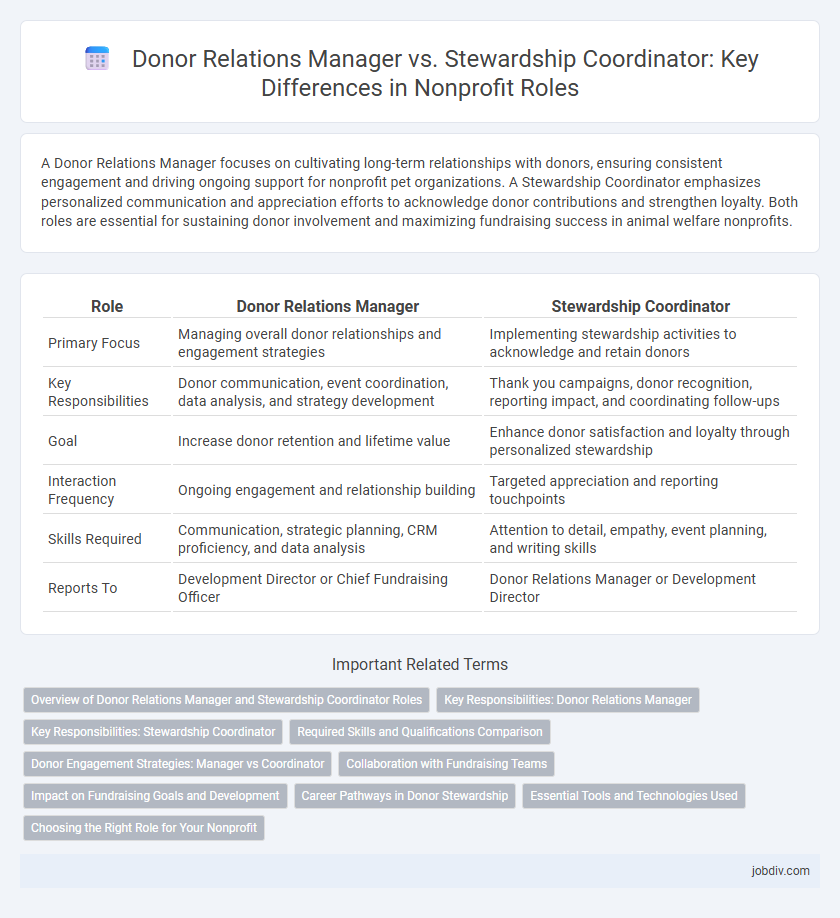A Donor Relations Manager focuses on cultivating long-term relationships with donors, ensuring consistent engagement and driving ongoing support for nonprofit pet organizations. A Stewardship Coordinator emphasizes personalized communication and appreciation efforts to acknowledge donor contributions and strengthen loyalty. Both roles are essential for sustaining donor involvement and maximizing fundraising success in animal welfare nonprofits.
Table of Comparison
| Role | Donor Relations Manager | Stewardship Coordinator |
|---|---|---|
| Primary Focus | Managing overall donor relationships and engagement strategies | Implementing stewardship activities to acknowledge and retain donors |
| Key Responsibilities | Donor communication, event coordination, data analysis, and strategy development | Thank you campaigns, donor recognition, reporting impact, and coordinating follow-ups |
| Goal | Increase donor retention and lifetime value | Enhance donor satisfaction and loyalty through personalized stewardship |
| Interaction Frequency | Ongoing engagement and relationship building | Targeted appreciation and reporting touchpoints |
| Skills Required | Communication, strategic planning, CRM proficiency, and data analysis | Attention to detail, empathy, event planning, and writing skills |
| Reports To | Development Director or Chief Fundraising Officer | Donor Relations Manager or Development Director |
Overview of Donor Relations Manager and Stewardship Coordinator Roles
Donor Relations Managers focus on building and maintaining strategic relationships with donors, overseeing communication, and ensuring long-term engagement to boost fundraising efforts. Stewardship Coordinators specialize in donor acknowledgment and appreciation, managing recognition programs to enhance donor satisfaction and loyalty. Both roles collaboratively support donor retention but differ in emphasis, with Donor Relations Managers concentrating on relationship growth and Stewardship Coordinators prioritizing donor gratitude and stewardship activities.
Key Responsibilities: Donor Relations Manager
A Donor Relations Manager oversees the development and execution of strategies to engage and retain donors by cultivating strong, personalized relationships and ensuring consistent communication. Key responsibilities include managing donor recognition programs, coordinating fundraising events, and analyzing donor data to tailor outreach efforts effectively. This role also involves collaborating with marketing and development teams to align messaging and enhance overall donor experience.
Key Responsibilities: Stewardship Coordinator
Stewardship Coordinators focus on maintaining long-term donor engagement by managing personalized communication, recognition programs, and tracking impact reporting to ensure donors feel valued and informed. They design and implement stewardship strategies that enhance donor loyalty, including organizing appreciation events and managing stewardship materials. Their key responsibility is to foster sustained giving through consistent, meaningful donor interactions and data-driven relationship management.
Required Skills and Qualifications Comparison
A Donor Relations Manager requires strong communication skills, experience in relationship management, and proficiency in CRM software to cultivate and maintain donor engagement effectively. In contrast, a Stewardship Coordinator emphasizes attention to detail, project management abilities, and expertise in donor recognition programs to ensure timely and personalized acknowledgment efforts. Both roles demand a background in fundraising or nonprofit management, but the Manager role focuses more on strategic planning, while the Coordinator prioritizes operational execution.
Donor Engagement Strategies: Manager vs Coordinator
Donor Relations Managers develop comprehensive donor engagement strategies, integrating personalized communication and long-term relationship building to maximize donor retention and lifetime value. Stewardship Coordinators focus on executing these strategies through tailored acknowledgments, event coordination, and impact reporting to strengthen donor trust and satisfaction. Both roles collaborate to ensure seamless donor experiences and optimize fundraising outcomes through targeted engagement efforts.
Collaboration with Fundraising Teams
A Donor Relations Manager and a Stewardship Coordinator both play crucial roles in nonprofit fundraising, with the former focusing on cultivating long-term donor relationships and the latter ensuring timely acknowledgment and reporting of donations. Collaboration with fundraising teams enables these roles to align donor engagement strategies with campaign goals, optimizing donor retention and revenue growth. Integrating efforts between donor relations and stewardship enhances communication workflows, leading to more personalized donor experiences and increased fundraising effectiveness.
Impact on Fundraising Goals and Development
Donor Relations Managers focus on building long-term relationships with donors, enhancing donor retention rates and increasing lifetime giving, which directly boosts fundraising revenue. Stewardship Coordinators ensure timely and personalized donor acknowledgments and reports, reinforcing donor trust and satisfaction that support recurring gifts and major gifts cultivation. Both roles strategically contribute to development by aligning donor engagement processes with organizational fundraising goals.
Career Pathways in Donor Stewardship
A Donor Relations Manager often advances by developing expertise in strategic donor engagement, moving towards leadership roles in fundraising or nonprofit development. A Stewardship Coordinator typically gains specialized skills in personalized donor recognition and impact reporting, creating a pathway to senior stewardship or donor experience positions. Both roles emphasize building long-term donor loyalty but differ in scope, with Donor Relations Managers overseeing broader donor portfolios and Stewardship Coordinators focusing on detailed stewardship activities.
Essential Tools and Technologies Used
Donor Relations Managers primarily use customer relationship management (CRM) software like Salesforce and Bloomerang to track donor engagement and analyze giving patterns, enhancing personalized communication strategies. Stewardship Coordinators rely heavily on grant management systems and impact reporting tools such as Fluxx and DonorPerfect to organize acknowledgment processes and generate detailed stewardship reports. Both roles integrate email marketing platforms like Mailchimp and social media management tools to maintain consistent donor communication and strengthen long-term relationships.
Choosing the Right Role for Your Nonprofit
Selecting between a Donor Relations Manager and a Stewardship Coordinator for your nonprofit depends on your organization's scale and donor engagement goals. A Donor Relations Manager typically focuses on building long-term relationships and strategic donor communications to increase major gifts and recurring donations. In contrast, a Stewardship Coordinator specializes in acknowledging donations and maintaining donor trust through personalized stewardship activities and timely reporting.
Donor Relations Manager vs Stewardship Coordinator Infographic

 jobdiv.com
jobdiv.com